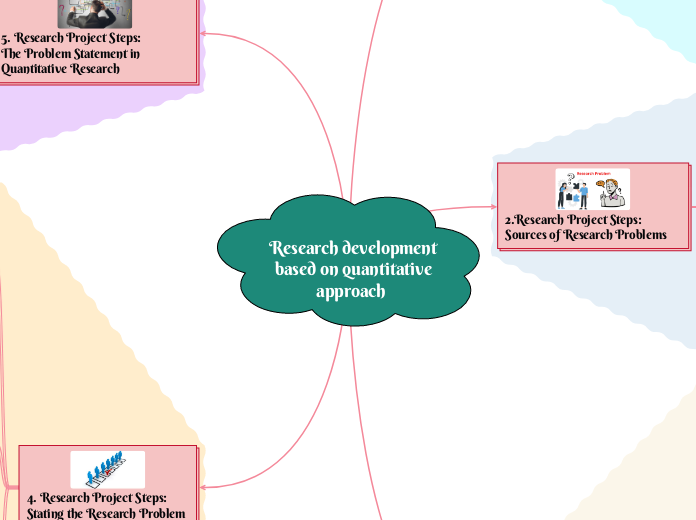Research development based on quantitative approach

1. Research Proyect step:Literature Review
For the most part, research in science revolves around the four Ps
people
problems
phenomena
programs
According to the type of study, the great value of one or more "Ps" will be highlighted
In this way, a group of individuals called people is selected to study
their behavior or attitude towards a problem
The research is focused on the study of the problem
the problem includes a phenomenon supported by the collected information
and the possible result proposed to solve said problem
Any research question, no matter how simple it may seem, needs to be thoroughly investigated
Depending on the type of literature review, the type of method to do it will also be altered
However, what should be given more importance is whether or not this bibliographic review is up-to-date, relevant and interesting to support the research question.

2.Research Project Steps: Sources of Research Problems
There are mainly three major sources
With these sources it is possible to obtain some information to find research problems
experience
is the most used source to acquire ideas that support the researcher to present a research problem based on personal experience from day to day.
deductions from theory
related literature.
This is published information on many topics in an area of interest.
Here we find great possibilities of discovering examples of research problems that are useful as models to develop other ones
offer
detailed information on the systematics of applied research
it is convenient to find a study that can be replicated or put into practice

3. Research Project Steps: Research Problem Selection
Interest
Motivate the researcher
Avoid wasting
Effor
Time
Magnitude
Enough information
Understanding of the research process
Measurement of concepts
research study
Using accurate indicators
Level of expertise
have experience
replicate an research
Relevance
Updated topics
Contribute to society
Availability of data
Originated
Secondary sources
Enough data available
Ethical issues
The questions
Not affect
Sample population

5. Research Project Steps:
The Problem Statement in Quantitative Research
Specify the variables and the population of interest.
The problem statement can be in:
Question:
It should find an answer to the research problem question, since it seems more direct to find the answer to such a question.
Statement
The problem to be investigated by the researcher is stated through the purpose of the study.

4. Research Project Steps:
Stating the Research Problem
How a problem is defined will determine each of the following steps:
Type of study design that can be used.
Type of sampling strategy that can be used
Research instrument that can be used or developed
Type of analysis that can be carried out".
To formulate the research problem, five aspects must be taken into account:
Define the research objectives
Analyze its context
Examine its nature
Determine the relationships between variables
Express in advance the probable consequences of alternative approaches.
Some questions can be asked to check if the stated problem is correct:
Does the research question allow for potential answers?
Is it testable, flexible and open-ended?
Is there sufficient evidence to pose it?
Is it possible to organize it into solvable parts?
Is it precise and clear?
Are there vague terms that need to be clarified?
Is it possible to explain why the solutions are valuable?
Are the premises explicit?
